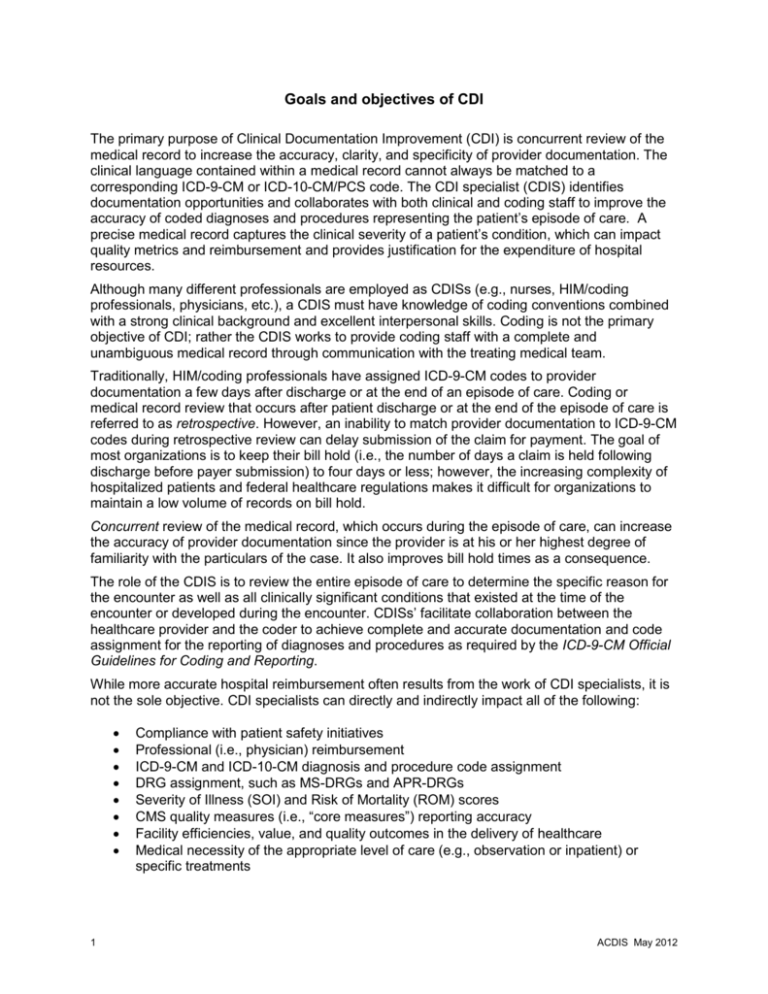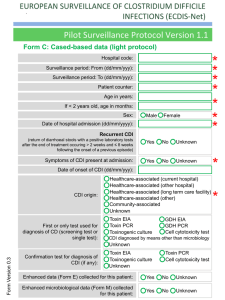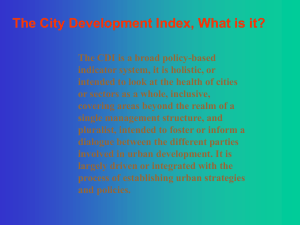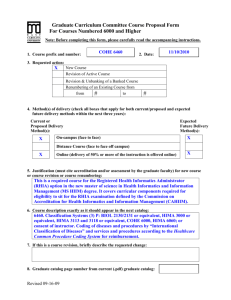Goals and objectives of CDI
advertisement

Goals and objectives of CDI The primary purpose of Clinical Documentation Improvement (CDI) is concurrent review of the medical record to increase the accuracy, clarity, and specificity of provider documentation. The clinical language contained within a medical record cannot always be matched to a corresponding ICD-9-CM or ICD-10-CM/PCS code. The CDI specialist (CDIS) identifies documentation opportunities and collaborates with both clinical and coding staff to improve the accuracy of coded diagnoses and procedures representing the patient’s episode of care. A precise medical record captures the clinical severity of a patient’s condition, which can impact quality metrics and reimbursement and provides justification for the expenditure of hospital resources. Although many different professionals are employed as CDISs (e.g., nurses, HIM/coding professionals, physicians, etc.), a CDIS must have knowledge of coding conventions combined with a strong clinical background and excellent interpersonal skills. Coding is not the primary objective of CDI; rather the CDIS works to provide coding staff with a complete and unambiguous medical record through communication with the treating medical team. Traditionally, HIM/coding professionals have assigned ICD-9-CM codes to provider documentation a few days after discharge or at the end of an episode of care. Coding or medical record review that occurs after patient discharge or at the end of the episode of care is referred to as retrospective. However, an inability to match provider documentation to ICD-9-CM codes during retrospective review can delay submission of the claim for payment. The goal of most organizations is to keep their bill hold (i.e., the number of days a claim is held following discharge before payer submission) to four days or less; however, the increasing complexity of hospitalized patients and federal healthcare regulations makes it difficult for organizations to maintain a low volume of records on bill hold. Concurrent review of the medical record, which occurs during the episode of care, can increase the accuracy of provider documentation since the provider is at his or her highest degree of familiarity with the particulars of the case. It also improves bill hold times as a consequence. The role of the CDIS is to review the entire episode of care to determine the specific reason for the encounter as well as all clinically significant conditions that existed at the time of the encounter or developed during the encounter. CDISs’ facilitate collaboration between the healthcare provider and the coder to achieve complete and accurate documentation and code assignment for the reporting of diagnoses and procedures as required by the ICD-9-CM Official Guidelines for Coding and Reporting. While more accurate hospital reimbursement often results from the work of CDI specialists, it is not the sole objective. CDI specialists can directly and indirectly impact all of the following: 1 Compliance with patient safety initiatives Professional (i.e., physician) reimbursement ICD-9-CM and ICD-10-CM diagnosis and procedure code assignment DRG assignment, such as MS-DRGs and APR-DRGs Severity of Illness (SOI) and Risk of Mortality (ROM) scores CMS quality measures (i.e., “core measures”) reporting accuracy Facility efficiencies, value, and quality outcomes in the delivery of healthcare Medical necessity of the appropriate level of care (e.g., observation or inpatient) or specific treatments ACDIS May 2012 Physician and hospital profiles, available on public websites such as healthgrades.com and hospitalcompare.hhs.gov Claims data used in CMS initiatives such as the readmission reduction program and the Value Based Purchasing (VBP) program Centers for Program Integrity (CPI) and private payer initiatives that focus on integrity fraud and abuse issues (e.g., Medicare RAC, Medicaid RAC, etc.) When initiating or revitalizing a CDI department it is important to understand the organizational objectives of the institution. Most CDI departments have limited resources and must focus on a few of the review areas listed above. As CDI departments mature, they often incorporate additional review areas from the above list. Often the primary goal of hospital administration regarding CDI is incremental reimbursement, increasing revenue through improved provider documentation leading to the capture of complications/comorbidities (CC) and major CCs (MCCs). CC/MCC capture affects the severity of the case, corresponding to higher resource consumption and higher reimbursement under the MS-DRG system. When the CDIS finds clinical indicators of an incomplete, vague, or missing diagnosis that meets coding guidelines of an “other” or secondary diagnosis, or encounters conflicting documentation, he or she works with the attending provider to clarify the documentation so it can be captured by an ICD-9-CM or ICD-10-CM/PCS code. Although a CDIS may engage in many different types of communication with the medical team, any communication regarding clarification of a specific medical record is referred to as a “query,” according to the American Health Information Management Association (AHIMA) 2010 practice brief, “Guidance for Clinical Documentation Improvement Programs.” The purpose of a physician query and/or physician clarification is to ensure that all diagnoses and treatments are documented in the medical record to the highest level of specificity substantiated by the patient’s clinical presentation and corresponding treatment. Complete, specific, and accurate provider documentation enhances a coder’s ability represent the medical encounter with ICD-9-CM, ICD-10-CM/PCS, and CPT-4 codes. CDI specialists also provide education to physicians and other healthcare providers regarding the importance of accurate and consistent documentation throughout the medical record. This education is often most effective when delivered to the individual provider on the hospital floor while discussing a specific patient. When possible, many CDISs join providers during their rounds, during which a provider completes his or her daily assessment of the patient’s condition. Collaboration during rounding expedites the documentation process as the provider receives real-time feedback while making an entry into the medical record. This process helps the provider understand how his or her documentation will be interpreted by coding and ensures that the provider’s clinical intent will be accurately captured. The goals and objectives of a CDI department also include collaborating with other departments and bridging the gap between HIM/coding staff and providers. Collaboration with other departments is critical to the continued success and growth of a CDI department. Examples are described below. Collaboration As a CDI department matures, creating partnerships with other departments can positively impact an organization’s finances and publicly reported data as well as decrease audit risks. Examples of how a CDIS can assist other departments include the following: 2 ACDIS May 2012 Case Management (CM) Providing CM staff with the geometric length of stay (GLOS) associated with the working DRG. This helps to ensure that discharge coincides with the GLOS to avoid expenditure of non-reimbursed hospital resources. Every MS-DRG has an associated relative weight, GLOS, and average length of stay (ALOS). CMS uses the relative weight, multiplied by the organization’s blended base rate, to determine an organization’s reimbursement. Organizations that accept Medicare beneficiaries agree to accept the MS-DRG rate as full payment for rendered services. A key component of MS-DRG reimbursement is the inclusion of anticipated room and board charges based on the GLOS associated with the principal diagnosis and applicable CCs or MCCs. Discharge of a patient within the GLOS associated with the working MS-DRG can result in greater profitability. Conversely, when the LOS extends beyond the GLOS associated with the working MSDRG, the hospital may lose revenue as the hospital continues to expend resources that will not be recouped from the payment. When reviewing a patient without a CC or MCC the CDIS ( in conjunction with CM) can assist in determining whether the extended LOS is possibly due to an incomplete, vague, or missing diagnosis, as opposed to discharge planning issues. Coding Ensuring the medical record presents an accurate clinical picture by querying for vague, missing, and/or incomplete diagnoses during the hospital stay and/or after discharge but prior to billing. Coders assign ICD-9-CM codes based on provider documentation in the medical record. However, the medical record does not always accurately reflect the intent of the provider and/or the patient’s clinical picture, leading to inaccurate or unspecified code assignment. Coders often are held accountable for increased bill hold times and delays in accounts receivable (AR). CDI specialists can positively impact bill hold times by initiating and completing queries on a concurrent basis, which allows coders to work from completed records. Analyzing audit data i.e., Program for Evaluating Payment Patterns Electronic Report (PEPPER) and validation audits with their coding manager regarding MS-DRG assignment based on principal diagnosis selection, code sequencing, and identification of secondary diagnoses. Both coding and CDI should be involved in the review of high vulnerability claims and outliers. Participating in/organizing joint educational efforts, especially regarding annual updates to the IPPS and quarterly issues of Coding Clinic. This ensures that both coders and CDIS are using the most current guidelines when reviewing the medial record. Working collaboratively with coding regarding ICD-10-CM/PCS implementation and educational efforts, with a particular focus on educating providers on the need for increased specificity. Compliance/ denials management/revenue cycle/RAC team Assisting with internal reviews of RAC findings to either appeal the RAC findings and/or adjust work flow processes to prevent future similar claims errors. Developing a monitoring process for MS-DRGs identified as high risk for payment error by Comprehensive Error Rate Testing (CERT) review and the RAC though regular review of their organizational PEPPER data. CDI staff can assist in the development of policies to address organizational vulnerabilities and a standardized monitoring/proficiency process. 3 ACDIS May 2012 HIM Assisting in the development and review of query templates and organizational definitions to ensure both legal and industry compliance. Developing educational sessions based on compliance monitoring of coding and CDI quality to ensure consistency in querying and coding practices within the organization. Involving the compliance department with provider educational efforts. Compliance staff can review the CDISs’ educational tools to ensure they do not erroneously force or pressure providers to document using particular diagnoses that increase reimbursement (i.e., promote “leading”). Compliance should reinforce the requirement that queries must be answered, but also ensure that the provider is not obligated to agree with the recommendations of CDI staff. Lastly, compliance should review any initiatives in which the provider is incentivized for cooperation with CDI efforts. Providing input on electronic medical record (EMR) design and implementation. CDISs’ should focus on products used by the medical staff such as CPOE, as the transition to electronic orders can result in lost documentation that was previously captured on paper order forms. Providing feedback regarding inaccurate use of copy and paste functions in which obsolete or inaccurate documentation is perpetuated through the medical record. Participating on the medical record and/or forms committee. CDISs should be involved due to their skill in reviewing the concurrent medical record and their insight into documentation prompting tactics that could be considered “leading,” or guiding the provider to a particular conclusion. Providers Educating the medical staff regarding the importance of their documentation on both professional and facility reimbursement, and developing tools that incorporate elements which can result in positive outcomes and appropriate reimbursement for both. The data elements that impact both facility and professional reimbursement include the following: o Review of Systems o History of Present Illness and Past Medical History o Daily progress notes o Discharge summary o Nurses’ notes o Death notes Educating physicians on their difference between ICD-9-CM procedure codes and CPT codes, including the impact of ICD-9-CM codes on core measures. Rounding with the medical team and helping them translate their clinical findings into diagnoses and/or terminology that can be captured by ICD-9 and/or ICD-10 codes. Educating the medical staff on ICD-10-CM/PCS and how documentation requirements will change with the new coding system. Educating providers on the impact their documentation has on hospital and physician quality scores. Quality Assisting with requirements under Value Based Purchasing (VBP). In fiscal year 2013 organizations must contribute one percent of their annual MS-DRG payment into a common pot that will be used to reward organizations that score well on specific quality measures. The number of quality measures and the contribution rate will increase in 4 ACDIS May 2012 both fiscal years 2014 and 2015. Many of these quality metrics are triggered by the presence of particular ICD-9-CM codes. Assisting with accurate capture of the expected mortality or acuity of the patient population. Collaboration between quality and CDI departments can positively impact the mortality index, which is the ratio of expected deaths compared to actual deaths. Many calculations of mortality are dependent upon the SOI and ROM values associated with the case, which are calculated using an APR-DRG grouper. CDI staff can review medical records to ensure accurate SOI/ROM assignment. Note that a focus on SOI/ROM involves more continued stay reviews than traditional MS-DRG review as multiple CCs and/or MCCs must be captured to ensure the highest SOI/ROM ratings. Working with providers to ensure that Present on Admission (POA) indicators are correctly assigned to complex diagnoses like pneumonia and sepsis when the diagnosis occurs later during the admission but the symptoms were present on admission. POA indicators are also used to identify Hospital Acquired Conditions (HAC). Often signs and symptoms of a condition exist on admission, but a corresponding diagnosis may not appear in the history and physical, requiring clarification by the CDIS of the condition’s status on admission when documented more than 24 hours into the admission. Note that if these particular ICD-9-CM codes appear in the medical record but were not identified as POA, the hospital is unable to use that ICD-9-CM code as a CC or MCC. Obtaining documentation for accurate reporting of AHRQ Patient Safety Indicators (PSI), a set of indicators providing information on potential hospital complications and adverse events following surgeries, procedures, and childbirth. For example, if a physician documents “acute respiratory failure” it will trigger PSI 11—(Postoperative respiratory failure). A CDI specialist can provide education to the provider on the appropriate uses of acute respiratory failure following surgery caused by a disease (which is not a PSI) vs. acute respiratory failure following surgery caused by the operative procedure (a PSI). Additionally, CDI staff can review records to capture AHRQ diagnoses, some of which are CCs, but the presence of which may impact mortality metrics. A CDIS can provide concurrent feedback to the medical team when a particular diagnosis may result in a PSI issue or a quality metric deficiency, and/or refer these cases to the quality department for follow up. Utilization Review Collaborating with UR to ensure correct assignment of the principal diagnosis when an inpatient admission follows an outpatient procedure or outpatient episode of care. Additionally, UR staff can educate CDI staff regarding the Medicare three day rule, which can impact MS-DRG assignment if an outpatient procedure becomes “linked” to an inpatient admission, causing the procedure to be unrelated to the principal diagnosis. Assisting with the establishment of medical necessity, especially for short stay admissions of two days or less. This includes analyzing PEPPER data in conjunction with UR to ensure strict adherence to screening criteria for symptom based MS-DRGs that are prone to short stay admissions of less than two days. These claims may result in denials due to a lack of medical necessity. CDI and UR should develop a process to review a sample these vulnerable claims at regular intervals to confirm that medical necessity criteria was met, and determine if additional documentation could have supported a more definitive principal diagnosis and MS-DRG assignment. Ensuring provider documentation reflects the exacerbation or increased acuity of a chronic condition necessitating inpatient care. Querying for the underlying etiology of a symptom principal diagnosis (e.g., chest pain, syncope, abdominal pain) to support inpatient care. 5 ACDIS May 2012 Nursing/patient safety Working cooperatively with the bedside nurse providing direct patient care. The bedside nurse has insight into the patient’s condition as well as the treatment plan that may not be fully conveyed in the medical record. Informing the bedside nurse when a query is issued may result in higher provider response rates as the nurse can bring the presence of the query to the attention of the medical team. In addition, proper documentation of a diagnosis through a physician query can help clinical staff better understand the treatment plan. Alerting appropriate clinical staff or informing nursing staff whenever quality of care issues arise. These issues may include medication errors, abnormal lab values, or inconsistencies in documentation (i.e., the provider refers to the left side in one progress note and the right side in another progress note when a unilateral event occurred). Although these discrepancies and findings may not impact ICD-9-CM code assignment, they can compromise the quality of patient care if not addressed. 6 ACDIS May 2012 Bridging the gap The role of the HIM/coding professional is evolving. More than ever coded data impacts quality reporting (i.e., Value Based Purchasing, facility/physician profiling). However, coding rules and guidance are often outpaced by clinical practice. This leads to discrepancies between physician intention and what can be captured by the limitations of ICD-9-CM codes. Although ICD-10CM/PCS may remedy some of the shortcomings of ICD-9-CM, coders are still limited by their ability to report codes from physician documentation that is often imprecise or non-specific. Often the documentation is sufficient enough to support the clinical picture, but may lack the specificity needed to report an appropriate ICD-9-CM/ICD-10-CM/PCS code. The role of the CDI specialist is to bridge the gap between the physician and coder—i.e., between clinical practice and the assignment of ICD-9-CM/ICD-10-CM/PCS codes. Through the work of the CDI specialist, a coder is better equipped to find the clinical intent of the provider. A mature CDI department can assist the medical team in providing concise, accurate documentation that meets both facility and professional coding needs without overwhelming the medical staff. 7 ACDIS May 2012




![CDI+Impact+on+RAC[1]](http://s2.studylib.net/store/data/005600152_1-87991b5e70e02cff6dbbfebd48f7ff80-300x300.png)
